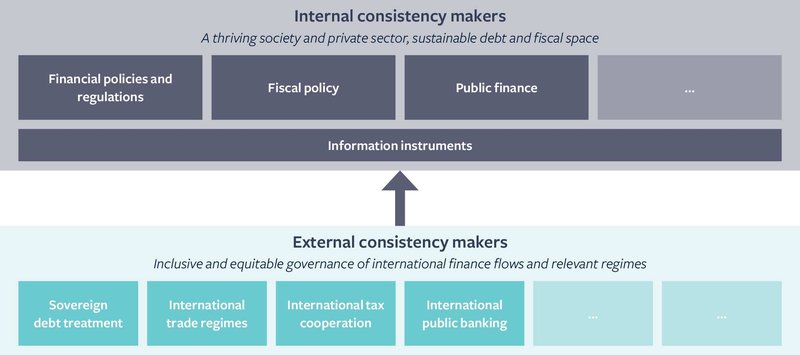The finance agenda at COP28 will be heavy. And, as we know, finance remains a central enabler of climate action. One of many items to discuss will be the Sharm el-Sheikh dialogue on the scope of Article 2, paragraph 1(c) of the Paris Agreement and its complementarity with Article 9 of the Paris Agreement. Two workshops were held in 2023, the result of deliberations on Article 2.1c at CMA4 in Egypt one year ago.
Article 2.1c aims to make “finance flows consistent with a pathway towards low greenhouse gas emissions and climate-resilient development”. The ongoing divergences in opinions on the scope of this goal however, continues to challenge its implementation. These divergences remain despite a recognition that the financial architecture is no longer fit for purpose in its current form.
ODI and Germanwatch propose that putting climate-resilient development at the heart of Article 2.1c presents an opportunity to refocus climate action and the finance that underpins it.
The climate-resilient development framing is a better way of capturing the preamble of Article 2, which calls for the pursuit of sustainable development and poverty alleviation. It is more representative of the fact that Article 2.1.c calls for neither adaptation nor mitigation by name. The IPCC in AR6 are clear: climate-resilient development requires the simultaneous consideration of sustainable development, adaptation and mitigation, while recognising there are trade-offs between these policy objectives. As such, centralising climate-resilient development could redress a growing concern that efforts towards Article 2.1.c implementation have so far focussed on mitigation and decarbonisation targets, rather than on adaptation or the pursuit of climate resilience. As such, this reframing also has the potential to unlock much needed adaptation finance flows and to decrease the amount of finance that flows towards mal-adaptation.
We further argue that Parties must be more intentional and systematic at centralising equity in the implementation of Article 2.1.c. This is embedded in Article 2.2, which calls for the implementation of the Paris Agreement to “reflect equity and common but differentiated responsibilities and respective capabilities, in light of different national circumstances”.
ODI and Germanwatch have dived into the actions taken to scale up and direct finance flows, through their providers, via the institutions that govern and regulate them. These ultimately set the incentives and disincentives that influence their decision-making at multiple scales that we call ‘consistency makers’. Much of the existing literature on Article 2.1c has focused on the national level and has identified mostly ‘internal’ consistency makers; those set by the State and influencing private and public sector actors within its jurisdiction. Fewer have considered ‘external’ consistency makers. Examples of which include guidance, frameworks, standards, or policies and laws that are decided upon in fora outside of the sole control of a State, but that have impacts across borders and ultimately on the State in question.
For example, international cooperation on sovereign debt could help provide the fiscal space needed for countries to increase financing for climate action domestically while a failure of such cooperation could constrain the successful creation of national enabling environments and negatively affect sustainable development outcomes, particularly in developing countries.
From the perspective of States as Parties to the Paris Agreement – and therefore actors that are ultimately responsible for its effective implementation - these internal-external interlinkages and potential impacts have equity considerations. Internal and external consistency makers set out in the figure below show that, despite internal consistency makers being familiar to governments, many developing countries face challenges in putting such tools in place to advance climate-resilient development - particularly for adaptation. This is because these national objectives can, in part, be facilitated or constrained by external consistency makers arising from international regimes, or from regulation put in place by other States with transnational effects. Critical for the equitable implementation of Article 2.1c to drive climate-resilient development are external consistency makers that address debt sustainability, international trade, taxation, international public banking and financial regulation, as well as the behaviour and alignment of corporations, for example.

These external consistency makers will need to be addressed outside of UNFCCC processes. Relevant forums to address them already exist. A successful and equitable implementation of Article 2.1c will depend on cooperation and inclusive governance arrangements in these existing forums so that external consistency makers work for all countries, particularly developing countries. The recent adoption of a resolution by the United Nations General Assembly to create a UN Framework Convention on International Tax Cooperation is an example of forums that could lead to more equitable regimes to address these external consistency makers. Other existing ones, like the World Trade Organisation (WTO), could also play such a role.
The inclusion of an invitation to continue the Sharm el-Sheikh dialogues into 2024 in the Secretariat report back to CMA5 is most welcomed. The UNFCCC must adopt a central and strong role to send the right signals and articulate the need for all these forums to contribute to climate resilient development. Deepening the understanding of Article 2.1c implementation through the climate-resilient development lens also holds the potential to create a wider base for common ground as deliberations continue.

